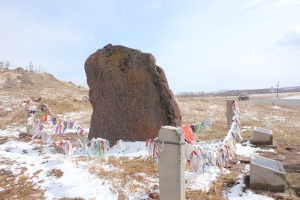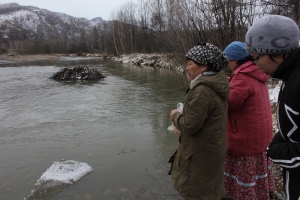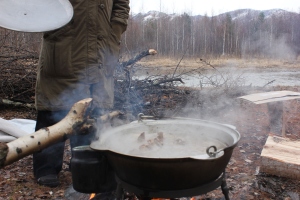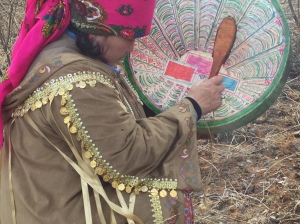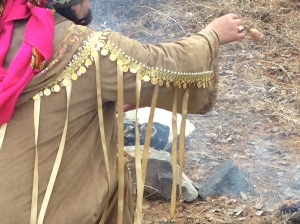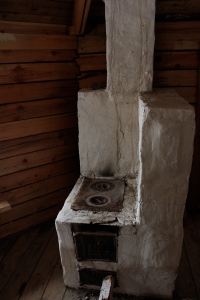After a conversation with Viktor Yakolevich Butanaev, a noted Khakas ethnographer, I came to the realization that shamanism does not exist. Years of repression under the soviet union wiped out the remnants of a religion that was once the spiritual center of Khakas culture. All that is left nowadays is neoshamanism, practiced by people who are eager to revive their ancestors’ culture. There is only one shaman society in Abakan, whose members, according to Butanaev, are charlatans.
“They don’t know anything. They have porridge in their heads,” he said, citing a popular Russian expression.
I still wanted to experience a shaman ritual, so I went to the Khakas Research Center in Abakan to ask for information about shamanism and phone numbers of local shamans. When I was there, I met Arbash, Turkish folklorist whose sole purpose in Abakan is to research shamanism. Using my best bullshitting skills, I convinced him that I was also researching shamanism and would love the opportunity to collaborate with him. He agreed. He told me to go to Khoon-Khoray, the only restaurant that serves traditional Khakas food in Abakan, to the weekly meetings held by a shaman society. There were at least fifteen people at the meeting, most of them women. Most of the people who belong to the Shaman society are people trying to rediscover their cultural roots thorugh shamanism. The meetings are opportunity for Khakas people to discuss ancient traditions and the origins of Khakas people. When I arrived to my first meeting, most of the members were speaking Khakas. I understood fragments of their conversation because they were constantly mixing Khakas and Russian in their speech and I was able to understand a few phrases.
I later found out that the main purpose of the meeting was to organize a Shiriné, a Khakas holiday that celebrates reawakening and the self-purification of the land. Prior to this special time of the year, shamans usually conduct rituals to prepare people for the spring and to give offerings to the spirits. These rituals are a way of giving thanks to nature and nourishing the spirits of loved ones. They were planning to go to Shirinsky district in mid April to perfom a ritual. The purposes and meaning of what they were going to do were not very clear to me, but I still wanted to go. After insisting and bothering people with my inquiries, I managed to convince the shaman society to let me tag along with them. We would be meeting on Saturday morning at one of Abakan’s open-air markets.
Shirinsky district is in the northern part of Khakassia and its know for its ancient landmark and geological wonders, such as the Sunduki mountains.
When I woke up at 8 am to go to the bus station, I was not expecting the raging blizzard I saw from my window. Since I am not a very outdoorsy person, I do not have clothes fit for a snowy, Siberian taiga. I put on the first thing I found that looked warm and left for my adventure. We met with the members of the shaman society at the North Market. The group was small: Arbash, the turiskish researcher; Me, the random Puerto Rican; Natalya Ilizerova and Sergey Danilovich, two shamans; and Anatoly, one of the members of the shaman society. There were also three women whose name I cannot recall, unfortunately; they were also members of the shaman society and they were in charged of helping Nataliya perform the rituals.
Before we could leave for Shirinsky District, we had to wait for Nataliya Ilizerova, the shaman, to buy the food that would be used as offerings during the ritual. Among some of the groceries they purchased, there was bread, milk, pirozhki, cookies, candies, and horse meat. Most of this food would be fed to the spirits, but humans were also allowed to eat.
I got to ride in the car with Natalia Ilizerova. She was holding her shaman drum on her lap, which was safely enclosed in a round, leather case. The woman providing the transportation was also a follower of shamanism and has attended rituals with Natalya before. They were talking about the recent death of a shaman and were planning to perform a ritual in his honor in order to feed his spirit. Nataliya, who seened to talked about spirits as if she knows them personally, said that he seemed weak that last time he saw him. Natalia told me that when a shaman dies, his or her drum is passed down to another shaman. According to ancient tradition, however, the drum of a dying shaman is was supposed ripped down the middle and hung from a tree.
As we were driving out of Abakan, we could hear the steel pot that was going to be used to cook the horse meant clattering in the trunk. Nataliya said that sound was not coincidental.
«Eat, eat, eat! The spirits want to eat!» Nataliya exclaimed playfully.
Natalia found out she had the gift of the shaman twenty years ago, when she began experiencing recurrent fainting spells.
“At first, I thought I had a serious health problem. After a while I realized it that my spirit was trying to escape my body in order to travel to other worlds.”
On our way to Shira, we had to make a couple of stops. The group decided to stop on the outskirts of Abakan, where one of Khakassia’s holy posts is located. In order to continue our journey, Natalya had to perform a ritual she referred to as “the opening of the road,” in which she would sprinkle ayran—fermented dairy beverage— and bread on ground, while asking the spirits to protect us during our travels.
We passed by mountains and ancient burial sites called kurgans. We stopped by another sacred site. It was a 5 feet stone dedicated to the memory of a shaman. We bowed to the stone and left offerings of bread and fermented milk.
The last and third stop before entering Shirinsky ra was not too far away from the stone. It was a birch tree garlanded with chalama ribbons. When I saw one of Natalya’s assistant taking out a Russian version of a pizza, I laughed a little when I found out the spirits ate pizza. Later on I found out that the food offered to spirits during rituals has to be food that the person ate when he or she was alive.
Although I was fascinated with the rituals and felt lucky to have the opportunity to experience shamanism firsthand, I felt uncomfortable with the notion of throwing food to the ground, even though I knew this food was meant to nurture the spirits and was a way to show gratitude to nature.
We drove on and reached the end of the paved road. We were heading into the taiga on gravel path. I was afraid that our car was going to die on us as we went further in between the mountains. We stopped by a yurt to ask for directions. I got out of the car to get some air and look at the mountains looming over us. When I looked at my phone to check the time, I saw that I had no signal. A feeling similar to agoraphobia dawned upon me when I realized we I was in the middle of nowhere with so-called shamans.
We spotted a trail of smoke emerging from in between the trees that was supposed to be our campfire. We dwelled further into the forest, trying to find where the smoke was coming from. Finally, we spotted two friendly faces waiting for us next to a bonfire by the river Белый Йус (Bely Yus). They were the groundkeepers of forest retreat called “Sputnik”, in which we were going to stay for the night.
The group began preparations for the ritual once we arrived to the camp. Anatoly, Sergey Danilovich and another man dressed in camouflage attire attended to the fire in which Natalya was going to prepare the horse meat she bought at the market. In the meantime, she and the other women went down to the river to give it offerings. The spot chosen by the shaman society was not coincidental. Shaman rituals are often held next to mountain because they are considered the dwelling place of spirits.
Before this trip, I had never gone camping in the woods. The only way I can build a fire is by setting fire to a pile of leaves and dousing it with lighter fluid. Using lighter fluid to ignite a fire is out of the questions for shamans. Fire, according to shaman beliefs, is a spirit and, at the same time, a holy conduit through which humans can communicate with spirit.
Anatoly, one of the members of the shaman society, and the rest of the men were building a small teepee out of sticks and hay that was going to serve as the ritual’s main bonfire. On a makeshift table made out of logs, the women set out food on the table for everybody. There were pastries, sausage, cheese, pizza, and candy. There were also some traditional Khakas dishes, such as talkhan, which consists of ground barley, butter, and sugar.
Horsemeat and barley were boiling in a cast-iron pot, also known as a казан (kazan) in Russian, while we sat and talked around the fire. Sergey Danilovich was an endless fountain of shaman knowledge. He talking about how the best remedy for sickness are beef broth and dumplings. The circular motion of grinding meat, Sergey explained, is sacred because it represents wholeness. Likewise, the yurt’s circular outline also represents life and the universe.
When the meat was ready and the conical formation of branches that was going to be lit on fire during the ritual was built.
With the help of the rest, Nataliya took out the meat from the pot and set on the tray. She began preparing a special Khakas dish known as потхы (potkhy), a type of porridge made out of flour, eggs, sour cream, ayran (sour milk), and butter. Anatoly told me that in Khakas culture this dish is usually made for special guests.
The women put on their traditional Khakas costumes and began preparing the ritual table, which they set next to the unlit bundle of branches. When everything was set, we gathered in the circle around the other bonfire. According to Khakas beliefs, hair is a strong source of energy and has to be wielded with care. In ancient times, Khakas woman used wear braids or cover their hair with scarves most of the time. For this ritual, I was asked to cover my hair. The men stood on the right while the women stood on the left side. The women assisting Natalya placed the offering on a small, long wooden table. These consisted of talghan (grinded barley with butter), candy, cheese, bread, pastries filled with meat and potatoes, a piece of pizza, a fermented milk beverage called ayran, potkhy, tea, and horse meat. Natalya also placed a small figurine of a horse and her drum next to the table. She was going to feed the spirits through the fire.
Fire, according to shamanic beliefs, is a goddess. In order to access the spirit world, a shaman must first appease the fire goddess by feeding her. The action of feeding the fire initiates communication with other spirits.
The ritual began when one of the men lit the fire. Natalya began chanting in Khakas and sprinkling ayran around her. She was convoking the spirits and harnessing nature. She lifted the offerings above her and recited a prayers in Khakas language. The woman assisting her handed her the food. With a spoon she sprinkled tea and ayran into the fire. She approached the fire with the tray of meat and knelt down. The vapors produced by the spirits consuming the food—i.e, the smell of burning food– is called khuyox in Khakas.The women helping Natalya went around in a circle feeding pieces of food into our mouths. The food consumed by the fire also had to be consumed by the people attending the ritual.
After shoving the offerings into the fire, Natalya began to bang her drum with a short, padded stick made out of lamb’s foot. As she banged her drum while another woman played the khomis( known as the jew’s harp in English). We stood around the fire, watching how it burned until the branch tepee collapsed and turned into a typical campfire. As the fire died out, Natalya gradually ceased her drumming. Before we could finalize the ritual, we had to go around the fire one time counterclockwise.
The women sprinkled the smoldering remains of the fire with а pleasant-smelling herb called irbén. After the ritual, shamans usually read the remains of the fire. Natalya gazed at the ashes and predicted that everything will be fine in the future.
The owner of the forest retreat let us stay in one of his cabins for the night, which was equipped with a Russian built-in stove made out of clay. Thanks to the lack of toilet in the cabin, I got to enjoy a moonlight walk in a real Russian taiga when I got up at 3:00 AM to use the bathroom, without getting ravaged by wolves and bears!
Above: A real Russian stove, the kind Chekhov described in his short stories. Hug this at once whenever you feel cold as fuck.
The next morning we went back to the spot where yesterday’s ritual was held. We had to feed the fire again before we could leave. Just like the day before, the men built a branch structure in the shape of a cone and lit it on fire. Natalya spoke her prayers and fed the fire. This time, the force of the spirits was strong and she asked everyone to kneel. When the ritual finished, Natalya said that spirits were going to use us to channel their wisdom.
Instead of conveying holy wisdom, we sat and sipped horse broth and ate the remaining offerings in silence. Natalya told us about what she saw while she was traveling between unseen worlds. She said she saw a woman with braided hair who was once was the local groundkeeper. There were wise, ancient men living the mountains who wanted to impart their knowledge to us.
Somehow I could tell Natalya was not satisfied. The drum, she said, did not allow her to travel beyond the earthly realm. She did not know what these wise men were trying to tell her.
In the meantime, Arbash was shoving his camera into peoples’ faces and asking the what they saw and felt during the ritual.
Unfortunately, nobody had anything to say.
